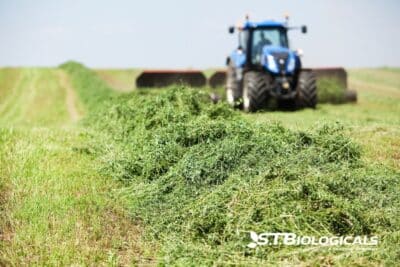Nutrient stratification is a characteristic of almost all disturbed soils. Organic, regenerative, and conventional farming disturb the soil and change the nutrient and biological balance.
In undisturbed soil, nutrients are deposited at the surface, and microbial activity decomposes the organic material. We don’t need to help a woodland or prairie because the soil organic matter (SOM) is high, microbial populations are well-fed, and nutrient cycling is balanced.
Compaction and Nutrient Stratification
Soil compaction is greater in conventional agriculture than regenerative ag. More passes over the field make compaction a bigger issue. Compaction is also a function of soil type. Clay and sandy soils can both compact and cause hardpans which are hard for roots to penetrate.
How does compaction affect stratification? Conventional farmers insist that incorporating nutrients into the soil through tillage makes them available for plant root uptake. But hardpan layers develop, which limits root development.
No-till puts nutrients in the top 2 inches of soil. Tillage in conventional agriculture is usually only 6 to 10 inches and fertilizers are only in the top 3 to 5 inches. So the nutrients are in the same place, no matter which method.
The question then becomes how to avoid nutrient stratification and the uneven distribution of nutrients for better crop performance.
Creating Channels for Nutrient Incorporation
We can create channels either with tillage, which increases compaction, or with cover crops. Soil biology is more effective at nutrient cycling in no-till systems. Maintaining living roots all year is a big bonus for nutrient retention. Those channels created by cover crop roots feed biology, restore soil structure, and increase moisture availability.
Naturally healthy soils have lots of earthworms and other microorganisms that incorporate nutrients deep into the soil. Surface runoff is a problem only when soil is bare. Burning, removal, or burying crop residue all result in less nutrient retention and more need for inputs the following season. Using your crop residue for erosion and pathogen control, carbon enhancement, and better nutrient cycling efficiency is wise farm practice.
To break down that crop residue, you need a robust microbial population. If you’ve been using synthetic chemicals, the chances are high you don’t have a strong beneficial microbial population. At ST Biologicals, we recommend a fall application of LiquiLife+ from Purple Cow Organics to break down your field stubble for easy planting in the spring.
LiquiLife+ is loaded with beneficial bacteria and fungi that feed on your crop residue. But they do their work more effectively when a secondary food source is added to jumpstart microbial activity. BioActive Super BioCharger, molasses, humic acids, and other food sources speed up the process.
Nutrient stratification isn’t a problem when you have a strong microbial population. Those microscopic allies in your soil do a lot of heavy work improving your soil so you don’t have to. To learn more about the microscopic world beneath your feet, contact our team at ST Biologicals. We’re here to help you succeed.

